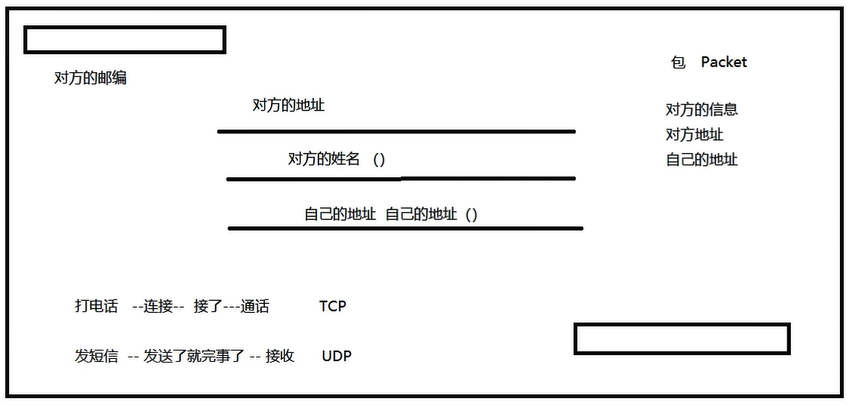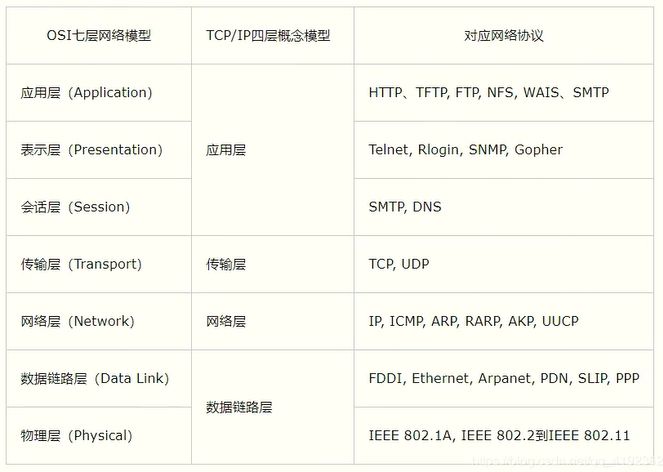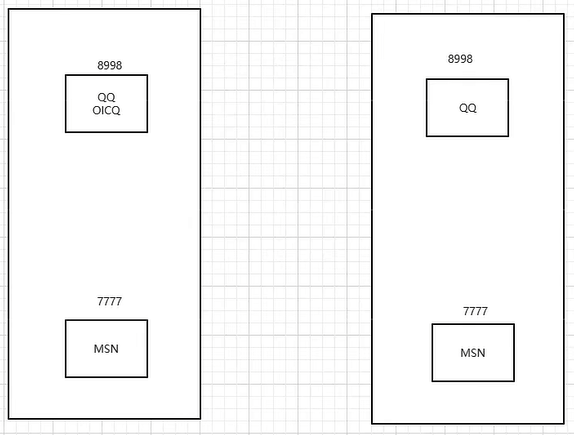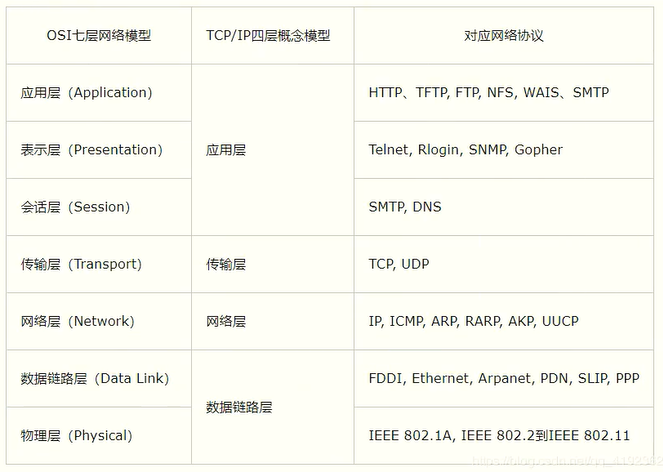Java网络编程
Java网络编程,
学习视频-狂神说Java网络编程:视频链接
网络编程
1.1、概述
地球村:你在西安,你一个美国的朋友!
信件:

计算机网络:
网络编程的目的:
- 无线电台...传播交流信息,数据交换。通信
想要达到这个效果组要什么:
-
如何准确的定位网络上的一台主机 192.168.16.124:端口,定位到这个计算机上的某个资源
-
找到了这个主机,如何传输数据呢?
javaweb:网页编程 B/S
网络编程:TCP/IP C/S
B/S 架构:全称:Browser/Server(浏览器/服务器)。
C/S 架构:全称:Client/Server (客户端/服务器)。
1.2、网络通信的要素
人工智能:智能汽车:工厂,人少!
如何实现网络的通信?
通信双方地址:
-
ip
-
端口号
-
192.168.16.124:5900
规则:网络通信的协议
TCP/IP参考模型:

小结:
-
网络编程中有两个主要的问题
-
如何准确的定位到网络上的一台或者多台主机
-
找到主机之后如何进行通信
-
-
网络编程中的要素
-
IP和端口号 IP
-
网络通信协议 UDP,TCP
-
-
万物皆对象
1.3、IP
ip地址:InetAddress
-
唯一定位一台网络上计算机
-
127.0.0.1:本机localhost
-
ip地址的分类
-
IPV4/IPV6
-
IPV4127.0.0.1,4个字节组成,0~255,42亿;30亿都在北美,亚洲4亿。2011年就用尽了 -
IPV6:128位,8个无符号整数!16个字节2022:100f:200e:300d:400c:500b:600a:0000!
-
-
公网(互联网)- 私网(局域网)
-
ABCD类地址
-
192.168.xx.xx, 专门给组织内部使用的
-
-
-
域名:记忆IP问题!
-
IP:
www.jd.compackage com.tang.IP; import java.net.InetAddress; import java.net.UnknownHostException; //测试IP public class TestInetAddress { public static void main(String[] args) { try { //查询本机地址 InetAddress inetAddress1 = InetAddress.getByName("127.0.0.1"); System.out.println(inetAddress1); // /127.0.0.1 InetAddress inetAddress3 = InetAddress.getByName("localhost"); System.out.println(inetAddress3); //localhost/127.0.0.1 InetAddress inetAddress4 = InetAddress.getLocalHost(); System.out.println(inetAddress4); //LAPTOP-0D02D60C/192.168.201.1 //查询网站IP地址 InetAddress inetAddress2 = InetAddress.getByName("www.baidu.com"); System.out.println(inetAddress2); //常用方法 // System.out.println(inetAddress2.getAddress()); System.out.println(inetAddress2.getCanonicalHostName()); //规范的名字,ip System.out.println(inetAddress2.getHostAddress()); //IP System.out.println(inetAddress2.getHostName()); //域名,或者自己电脑的名字 System.out.println(inetAddress1.getHostName()); //activate.navicat.com System.out.println(inetAddress3.getHostName()); //localhost System.out.println(inetAddress4.getHostName()); //电脑名: LAPTOP-0D02D60C } catch (UnknownHostException e) { e.printStackTrace(); } } }
-
1.4、端口
端口表示就是就是的一个程序的进程;
-
不同的进程有不同的端口号!用来区分软件!
-
被规定0~65535
-
TCP,UDP:65535*2 TCP:80,UDP:80,单个协议下,端口号不能冲突
-
端口分类
-
共有端口0~1023
-
HTTP:80
-
HTTP:443
-
FTP:21
-
Telent:23
-
-
程序注册端口:1024~49151,分配给用户或者程序
-
Tomcat:8080
-
MySQL:3306
-
Oracle:1521
-
-
动态、私有:49152~65535
netstat -ano #查看所有的端口 netstat -ano|findstr "7780" #查看指定的端口 tasklist|findstr "15168" #查看指定端口的进程 Ctrl+Shift+Esc #打开任务管理器package com.tang.IP; import java.net.InetSocketAddress; //测试端口 public class TestInetSocketAddress { public static void main(String[] args) { InetSocketAddress socketAddress = new InetSocketAddress("127.0.0.1", 8080); InetSocketAddress socketAddress2 = new InetSocketAddress("localhost", 8080); System.out.println(socketAddress); // /127.0.0.1:8080 System.out.println(socketAddress2); // localhost/127.0.0.1:8080 System.out.println(socketAddress.getAddress()); // /127.0.0.1 System.out.println(socketAddress.getHostName()); //activate.navicat.com System.out.println(socketAddress.getPort()); // 8080 System.out.println(socketAddress2.getAddress()); // localhost/127.0.0.1: ip地址名/ip地址 System.out.println(socketAddress2.getHostName()); // localhost: ip地址名 System.out.println(socketAddress2.getPort()); // 8080 } } -
端口映射

-
1.5、通信协议
协议:约定,就好比我们现在说的是普通话
网络通信协议:速率,传输码率,代码结构,传输控制......
问题:非常的复杂?
大事化小:分层!
TCP/IP协议簇:实际上是一组协议
重要:
-
TCP:用户传输协议
-
UDP:用户数据报协议
出名的协议:
-
TCP:
-
IP:网络互联协议

TCP UDP 对比
TCP:打电话
-
连接,稳定
-
三次握手,四次挥手
最少需要三次,保证稳定连接! A:你瞅啥? B:瞅你咋地? A:干一场! A:我要走了 B:你真的要走了吗? B:你真的真的要走了吗? A:我真的走了 -
客户端、服务端
-
传输完成,释放连接,效率低
UDP:发短信
-
不连接,不稳定
-
客户端、服务端:没有明确的界限
-
不管有没有准备好,都可以发给你...
-
导弹
-
DDOS:洪水攻击!(饱和攻击)
1.6、TCP
客户端
-
连接服务器Socket
-
发生消息
package com.tang.tcp;
import java.io.IOException;
import java.io.OutputStream;
import java.net.InetAddress;
import java.net.Socket;
//客户端
public class TcpClientDemo01 {
public static void main(String[] args) {
Socket socket = null;
OutputStream os = null;
try {
//1.要知道服务器的地址
InetAddress serverIP = InetAddress.getByName("127.0.0.1");
int port = 9999;
//2.创建一个socket连接
socket = new Socket(serverIP, port);
//3.发送消息 IO流
os = socket.getOutputStream();
os.write("糖果学Java".getBytes());
} catch (Exception e) {
e.printStackTrace();
}finally {
if (os!=null) {
try {
os.close();
} catch (IOException e) {
e.printStackTrace();
}
}
if (socket!=null) {
try {
socket.close();
} catch (IOException e) {
e.printStackTrace();
}
}
}
}
}
服务器
-
建立服务的端口ServerSocket
-
等待用户的连接 ss.accept
-
接收用户的消息
package com.tang.tcp;
import java.io.ByteArrayOutputStream;
import java.io.IOException;
import java.io.InputStream;
import java.net.ServerSocket;
import java.net.Socket;
//服务端
public class TcpServerDemo01 {
public static void main(String[] args) {
ServerSocket serverSocket = null;
Socket socket = null;
InputStream is = null;
ByteArrayOutputStream baos = null;
try {
//1.我要有一个地址
serverSocket = new ServerSocket(9999);
while (true) {
//2.等待客户端连接过来
socket = serverSocket.accept();
//3.读取客户端的消息
is = socket.getInputStream();
//管道流
baos = new ByteArrayOutputStream();
byte[] buffer = new byte[1024];
int len;
while ((len = is.read(buffer)) != -1) {
baos.write(buffer, 0, len);
}
System.out.println(baos.toString());
}
} catch (IOException e) {
e.printStackTrace();
}finally {
//关闭流
if(baos!=null){
try {
baos.close();
} catch (IOException e) {
e.printStackTrace();
}
}
if(is!=null) {
try {
is.close();
} catch (IOException e) {
e.printStackTrace();
}
}
if(socket!=null) {
try {
socket.close();
} catch (IOException e) {
e.printStackTrace();
}
}
if(serverSocket!=null) {
try {
serverSocket.close();
} catch (IOException e) {
e.printStackTrace();
}
}
}
}
}
文件上传
客户端
package com.tang.tcp;
import java.io.*;
import java.net.InetAddress;
import java.net.Socket;
//客户端
public class TcpClientDemo02 {
public static void main(String[] args) throws Exception {
//1.创建一个socket连接
Socket socket = new Socket(InetAddress.getByName("127.0.0.1"), 9000);
//2.创建一个输出流
OutputStream os = socket.getOutputStream();
//3.读取文件
FileInputStream fis = new FileInputStream(new File("网络编程\\src\\com\\tang\\tcp\\aaa.gif"));
//4.写出文件
byte[] buffer = new byte[1024];//大公司不允许,会造成资源浪费
int len;
while ((len=fis.read(buffer))!=-1){
os.write(buffer,0,len);
}
//通知服务器,我已经结束了
socket.shutdownOutput(); //我已经传输完了
//确定服务端接收完毕,才能够断开连接
InputStream inputStream = socket.getInputStream();
//String byte[]
ByteArrayOutputStream baos = new ByteArrayOutputStream();
byte[] buffer2 = new byte[1024];
int len2;
while ((len2=inputStream.read(buffer2))!=-1){
baos.write(buffer2,0,len2);
}
System.out.println(baos.toString());
//5.关闭资源
baos.close();
inputStream.close();
fis.close();
os.close();
socket.close();
}
}
服务端
package com.tang.tcp;
import java.io.*;
import java.net.ServerSocket;
import java.net.Socket;
//服务端
public class TcpServerDemo02 {
public static void main(String[] args) throws Exception {
//1.创建服务
ServerSocket serverSocket = new ServerSocket(9000);
//2.监听客户端的连接
Socket socket = serverSocket.accept();//阻塞式监听,会一直等待客户端连接
//3.获取输入流
InputStream is = socket.getInputStream();
//4.文件输出
FileOutputStream fos = new FileOutputStream(new File("网络编程\\src\\com\\tang\\tcp\\receive.gif"));
byte[] buffer = new byte[1024];
int len;
while ((len=is.read(buffer))!=-1){
fos.write(buffer,0,len);
}
//通知客户端我接收完毕了
OutputStream os = socket.getOutputStream();
os.write("我接收完毕了,你可以断开了".getBytes());
//5.关闭资源
os.close();
fos.close();
is.close();
socket.close();
serverSocket.close();
}
}
Tomcat
服务端
-
自定义 S
-
Tomcat服务器 S:java后台开发
-
Windows下启动:bin\startup.bat
-
Windows下关闭:bin\shutdown.bat
-
webapps:web应用,项目
-
conf\logging.properties:修改编码
-
客户端
-
自定义 C
-
浏览器 B
1.7、UDP
发短信:不用连接,需要知道对方的地址!
发送消息
发送端
package com.tang.udp;
import java.net.DatagramPacket;
import java.net.DatagramSocket;
import java.net.InetAddress;
//不需要连接服务器
public class UdpClientDemo01 {
public static void main(String[] args) throws Exception {
//1.建立一个socket
DatagramSocket socket = new DatagramSocket();
//2.建个包
String msg = "hello,server,服务端";
InetAddress localhost = InetAddress.getByName("localhost"); //发送给服务端
int port = 9090;
// 数据,数据的起始,要发送给
DatagramPacket packet = new DatagramPacket(msg.getBytes(), 0, msg.getBytes().length, localhost, port);
//3.发个包
socket.send(packet);
//4.关闭流
socket.close();
}
}
接收端
package com.tang.udp;
import java.net.DatagramPacket;
import java.net.DatagramSocket;
//还是要等到客户端的链接!
public class UdpServerDemo01 {
public static void main(String[] args) throws Exception {
//开放端口
DatagramSocket socket = new DatagramSocket(9090);
//接收数据
byte[] buffer = new byte[1024];
DatagramPacket packet = new DatagramPacket(buffer, 0, buffer.length);//接收
socket.receive(packet); //阻塞接收
System.out.println(packet.getAddress().getHostAddress());
System.out.println(new String(packet.getData(),0,packet.getLength()));
//关闭连接
socket.close();
}
}
循环发送消息
发送者
package com.tang.udp.chat;
import java.io.BufferedReader;
import java.io.InputStreamReader;
import java.net.DatagramPacket;
import java.net.DatagramSocket;
import java.net.InetSocketAddress;
public class UdpSenderDemo01 {
public static void main(String[] args) throws Exception {
//创建数据插槽: 用来发送/接收数据
DatagramSocket socket = new DatagramSocket(8888);
//创建包:
// 准备数据: 控制台读取System.in
BufferedReader reader = new BufferedReader(new InputStreamReader(System.in));
while (true) {
String data = reader.readLine(); //读取一行
byte[] dataBytes = data.getBytes(); //字符→字节
DatagramPacket packet = new DatagramPacket(dataBytes, 0, dataBytes.length, new InetSocketAddress("localhost", 6666));
//发送包
socket.send(packet);
if (data.equals("bye")){
break;
}
}
//关闭资源
socket.close();
}
}
接收者
package com.tang.udp.chat;
import java.net.DatagramPacket;
import java.net.DatagramSocket;
public class UdpReceiveDemo01 {
public static void main(String[] args) throws Exception {
//创建数据插槽: 用来发送/接收数据
DatagramSocket socket = new DatagramSocket(6666);
while (true) {
//准备接收包裹
byte[] container = new byte[1024];//容器,缓冲区
DatagramPacket packet = new DatagramPacket(container, 0, container.length);
socket.receive(packet);//阻塞式接收包裹
//打印接收数据
byte[] data = packet.getData();
String receiveData = new String(data, 0, packet.getLength());
System.out.println(receiveData);
/*
//打印出的结果后面多出来一堆空格,总长度等于container.length,
// 所以,不能使用packet.getData().length, 必须使用packet.getLength()
String receiveData2 = new String(data, 0, data.length);
System.out.println(receiveData2);
System.out.println(packet.getData().length); //容器长度container.length
System.out.println(packet.getLength()); //实际传入的字节的长度
*/
//断开连接 bye
if (receiveData.equals("bye")){
break;
}
}
//关闭资源
socket.close();
}
}
在线咨询,两个人都可以是发送方,也都可以是接收方!
双方互发消息
发送线程
package com.tang.udp.chat;
import java.io.BufferedReader;
import java.io.IOException;
import java.io.InputStreamReader;
import java.net.DatagramPacket;
import java.net.DatagramSocket;
import java.net.InetSocketAddress;
import java.net.SocketException;
public class TalkSend implements Runnable{
DatagramSocket socket = null;
BufferedReader reader = null;
private int fromPort;
private String toIP;
private int toPort;
public TalkSend(int fromPort, String toIP, int toPort) {
this.fromPort = fromPort;
this.toIP = toIP;
this.toPort = toPort;
try {
//创建数据插槽: 用来发送/接收数据
socket = new DatagramSocket(fromPort);
//创建包:
// 准备数据: 控制台读取System.in
reader = new BufferedReader(new InputStreamReader(System.in));
} catch (Exception e) {
e.printStackTrace();
}
}
@Override
public void run() {
while (true) {
try {
String data = reader.readLine(); //读取一行
byte[] dataBytes = data.getBytes(); //字符→字节
DatagramPacket packet = new DatagramPacket(dataBytes, 0, dataBytes.length, new InetSocketAddress(toIP, toPort));
//发送包
socket.send(packet);
if (data.equals("bye")){
break;
}
} catch (Exception e) {
e.printStackTrace();
}
}
//关闭资源
socket.close();
}
}
接收线程
package com.tang.udp.chat;
import java.io.IOException;
import java.net.DatagramPacket;
import java.net.DatagramSocket;
import java.net.SocketException;
public class TalkReceive implements Runnable{
DatagramSocket socket = null;
private int port;
private String msgFrom;
public TalkReceive(int port,String msgFrom) {
this.port = port;
this.msgFrom = msgFrom;
try {
//创建数据插槽: 用来发送/接收数据
socket = new DatagramSocket(port);
} catch (SocketException e) {
e.printStackTrace();
}
}
@Override
public void run() {
while (true) {
try {
//准备接收包裹
byte[] container = new byte[1024];
DatagramPacket packet = new DatagramPacket(container, 0, container.length);
socket.receive(packet);//阻塞式接收包裹
//打印接收数据
byte[] data = packet.getData();
String receiveData = new String(data, 0, packet.getLength());
System.out.println(msgFrom+": "+receiveData);
//断开连接 bye
if (receiveData.equals("bye")){
break;
}
} catch (IOException e) {
e.printStackTrace();
}
}
//关闭资源
socket.close();
}
}
学生
package com.tang.udp.chat;
public class TalkStudent {
public static void main(String[] args) {
//开启两个线程
new Thread(new TalkSend(5555, "localhost", 8888)).start();
new Thread(new TalkReceive(9999, "老师")).start();
}
}
老师
package com.tang.udp.chat;
public class TalkTeacher {
public static void main(String[] args) {
//开启两个线程
new Thread(new TalkSend(6666, "localhost", 9999)).start();
new Thread(new TalkReceive(8888, "学生")).start();
}
}
1.8、URL
统一资源定位符:定位资源,定位互联网上的某一个资源
DNS域名解析:域名解析成IP www.baidu.com xxx.x..x..x
协议://ip地址:端口号/项目名/资源
http://127.0.0.1:8080/JavaSE-狂神说/网络编程
# 项目tangguo,文件SecurityFile.txt
D:\Program Files\tomcat\apache-tomcat-9.0.59\webapps\tangguo\SecurityFile.txt
# 访问地址
http://localhost:8080/tangguo/SecurityFile.txt
package com.tang.url;
import java.net.MalformedURLException;
import java.net.URL;
// http://localhost:8080/tangguo/SecurityFile.txt
public class UrlDemo01 {
public static void main(String[] args) throws MalformedURLException {
URL url = new URL("http://localhost:8080/helloword/index.jsp?username=tangguo&password=123");
System.out.println(url.getProtocol());//协议名
System.out.println(url.getHost());//主机IP
System.out.println(url.getPort());//端口
System.out.println(url.getPath());//文件地址
System.out.println(url.getFile());//文件全路径
System.out.println(url.getQuery());//查询参数
}
}
下载文件
package com.tang.url;
import java.io.FileOutputStream;
import java.io.InputStream;
import java.net.HttpURLConnection;
import java.net.URL;
public class UrlDown {
public static void main(String[] args) throws Exception {
//1.下载地址
URL url = new URL("http://localhost:8080/tangguo/SecurityFile.txt");
//URL url = new URL("https://m10.music.126.net/20220521135233/403cbbcf88c42215c319cdb3e7a918d5/yyaac/obj/wonDkMOGw6XDiTHCmMOi/3681245194/7863/c6de/e057/326944db288f30186221752c7f37a06e.m4a");
//2.连接到这个资源 HTTP
HttpURLConnection urlConnection = (HttpURLConnection) url.openConnection();
//输入流
InputStream inputStream = urlConnection.getInputStream();
//文件输出流
FileOutputStream fos = new FileOutputStream("网络编程\\src\\com\\tang\\url\\SecurityFile.txt");
//FileOutputStream fos = new FileOutputStream("网络编程\\src\\com\\tang\\url\\忘记时间.m4a");
//FileOutputStream fos = new FileOutputStream("D:\\IT\\JavaSE-狂神说\\网络编程\\src\\com\\tang\\url\\忘记时间.m4a");
byte[] buffer = new byte[1024]; //缓冲区1024
int len;
while ((len=inputStream.read(buffer))!=-1){
fos.write(buffer,0,len);//写出这个数据
}
fos.close();
inputStream.close();
urlConnection.disconnect();//端口连接
}
}


 浙公网安备 33010602011771号
浙公网安备 33010602011771号